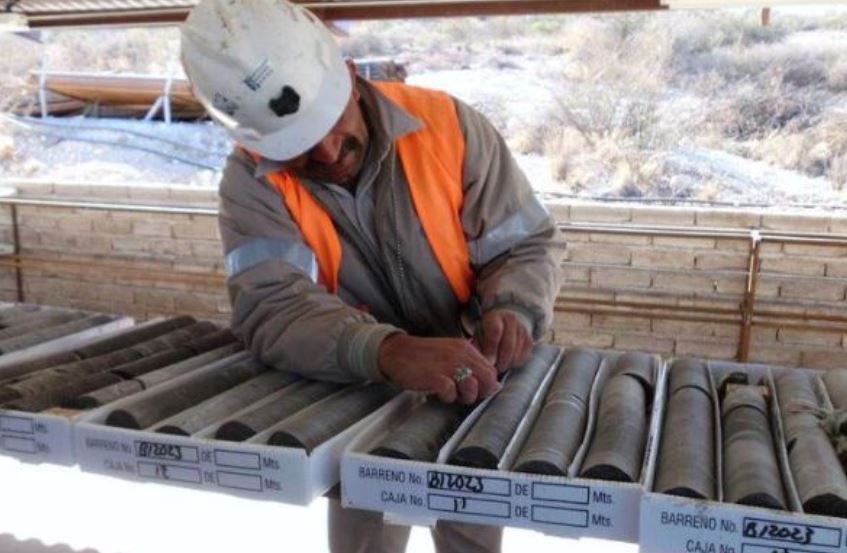Silver Bull drills 294 g/t silver/0.96% copper over 25.5 m at Sierra Mojada

Logging diamond drill core at the Sierra Mojada Project in Coahuila, northern Mexico. Source: Silver Bull Resources, Inc.
Silver Bull Resources, Inc. [SVB-TSX; SVBL-OTCQB] reported results of the first two drill holes from its underground drill program targeting high grade structures in the newly discovered Sulphide Zone on the Sierra Mojada Project in Coahuila, northern Mexico. Highlights from the first two drill holes include:
- Hole T17002 – 25.5 meters of 29 4g/t silver and 0.96% copper, including 11.5 meters of 486 g/t silver and 1.13% copper from 14 – 25.5 meters, and which contains a smaller interval of 4 meters of 966 g/t silver and 2.0% copper from 15 – 19 meters.
- Hole T17002 hit underground workings and was terminated in high grade mineralization.
- Hole T17001 – 7 meters of 121 g/t silver and 0.52% copper including 2 meters of 376 g/t silver and 3.0% copper from 0 – 2 meters.
The Sulphide Zone: An underground geological mapping and continuous underground channel sampling program conducted by Silver Bull during August identified a series of east-west trending high-angle structure hosting sulphide mineralization. Results from the continuous channel sampling program yielded 31.5 meters grading at 22.36% zinc, 134.5 g/t silver, 2.05% lead, 0.21% copper and 10.5 meters of 432 g/t silver, 1.15% zinc, 0.05% lead, 1.22% copper. This sulphide zone is the target of the current drill program.
The Drill Program: Silver Bull is utilizing a company-owned Termite drill rig to test the grade, thickness, and continuity of the sulphide mineralization identified by the channel sampling program. The Termite is capable of drilling up to 100 meters of NQ diamond core and five drill stations are presently planned with more expected to be added as continued mapping in previously unvisited underground workings and drilling progresses.
The Results: The results from the first two holes confirm the grade and east-west continuity of the first of three structures to be drilled. It is important to note that drill hole T17002 was terminated in high grade mineralization when it hit a previously unmapped stope. Unlike the other structures sampled in the area, we saw no appreciable lead or zinc in these first two drill holes and is interpreted to represent either a zoning of the metals in the system or a different pulse of sulphide mineralization all together. The drilling also confirmed the presence of a low grade halo of silver and copper mineralization up to 10 meters wide and grading up to 90g/t silver and 0.2% copper. Two other similar east-west trending structures have been identified in the same area 70 meters to the south and which will be the target of our continued drill program.
Tim Barry, President, CEO, stated, “We are very pleased with the first two holes of our program which confirm what we are seeing underground with our mapping. With these first drill holes we have extended the first of the three high grade structures we plan to drill, another 25 meters to the east and it almost certainly continues as the hole was ended in high grade mineralization due to hitting an unmapped void. This structure remains open along strike and down dip. It is also important to note that we appear to be below the oxide zone and expect to continue hitting sulphide mineralization in this area.”
Sierra Mojada is an open pittable oxide deposit, as disclosed in a NI 43-101 Technical Report with a compliant measured and indicated “global” resource of 58.7 million tonnes grading 3.6% zinc and 50 g/t silver at a $13.50 NSR cutoff giving 4.670 billion pounds of zinc and 90.8 million ounces of silver. Included within the “global” resource is a measured and indicated “high grade zinc zone” within the Lerchs-Grossman Optimized Pit of 10.03 million tonnes with an average grade of 11% zinc at a 6% cutoff, giving 2.426 billion pounds of zinc, and a measured and indicated “high grade silver zone” of 19 million tonnes with an average grade of 102.5g/t silver at a 50g/t cutoff giving 62.6 million ounces of silver. Mineralization remains open to the east, west and north.
